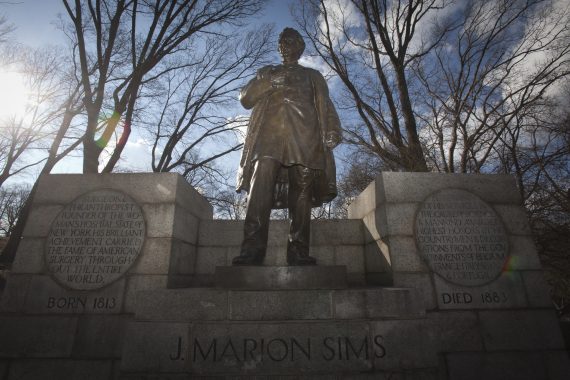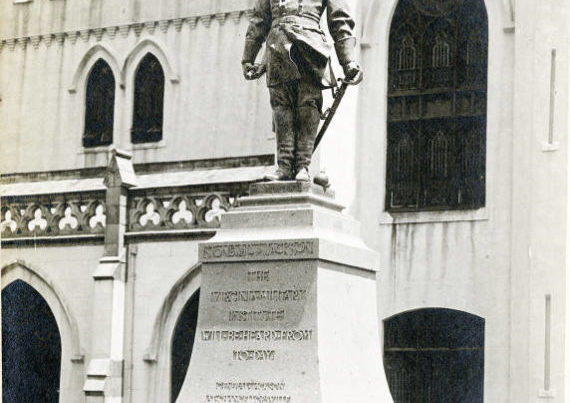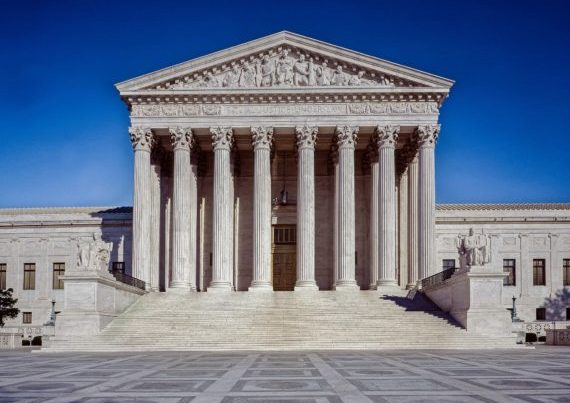Over the years, countless thousands the New Yorkers have passed by monuments in their city that were dedicated to two eminent physicians who were related by marriage, but there is little doubt that few of them, until recently at least, had ever realized that the statues were erected in memory of former Southerners. The two men of medicine were Dr. James Marion Sims of Lancasterville, South Carolina, and his son-in-law, Dr. John Allan Wyeth of Guntersville, Alabama. Dr. Wyeth had been a Confederate cavalryman who served under Generals John Hunt Morgan, Joseph Wheeler and Nathan Bedford Forrest, and whose 1899 biography, “That Devil Forrest,” effectively dealt with the charges that the general had been responsible for the massacre of Union troops, mostly African-Americans, at Fort Pillow in Tennessee and had been a leading member of the Ku-Klux Klan from 1867 to 1869. It is, however, the statue of Dr. Sims, a man who had never served the Confederacy in any capacity, that has become the focus of racial controversy and cries to have his monument removed.
After graduating from South Carolina College in Columbia, Sims began his medical studies with a physician in Lancaster, South Carolina, as well as taking courses at the Medical College of Charleston. He later graduated from Jefferson Medical College in Philadelphia, Pennsylvania, and then moved to Alabama where he opened a women’s clinic in Montgomery in 1845. It was there Dr. Sims began his pioneering work to correct a condition that caused obstructed childbirth, work that, many years later, would become controversial and, because his initial subjects were three female black slaves, has given rise to the current charges of racism. The attacks are based on the argument that, while the women were indeed suffering from the condition Dr. Sims was attempting to correct, they were not willing subjects of the operations. It is further charged that Dr. Sims employed no anesthetic during the procedures, the use of which, in itself, was highly controversial among members of America’s medical profession in the early Nineteenth Century.
In 1853, Dr. Sims moved his medical practice to New York City, and two years later he founded America’s first full-scale hospital for women and was hailed as the “father of modern gynecology.” In addition, he was also involved with launching America’s first cancer facility, the New York Cancer Hospital, once served as president of the American Medical Association and was the author of a number of major medical papers and books, including, somewhat ironically, the 1879 volume “The History of the Discovery of Anaesthesia.” During the War Between the States, Sims was practicing medicine in London and Paris, and was appointed surgeon to the Empress Eugénie, wife of French Emperor Napoleon III. Before returning to America in 1871, Dr. Sims was also instrumental in creating an Anglo- American ambulance corps that treated both French and German troops wounded during the Franco-Prussian War.
In recognition of his many contributions to the field of medicine, memorials to Dr. Sims have been erected at the Jefferson Medical College in Philadelphia, the Alabama State Capitol in Montgomery and at both the South Carolina State Capitol in Columbia and his birthplace in Lancaster County, as well the life-size statue of him in Manhattan, the first such monument to a physician in the United States. The latter memorial, which some are now demanding be removed, was created in 1894 by the German sculptor, Ferdinand Freiherr von Miller, who also made the Confederate Memorial at Magnolia Cemetery in Charleston, South Carolina. Dr Sims’ New York statue was first placed in Bryant Park on 42nd Street, the present site of the New York Public Library, and was later moved sixty blocks north to a location in Central Park opposite the New York Academy of Medicine. With the present calls for a total removal of the statue, we are once again faced with yet another example of that which was considered socially and morally correct, even praiseworthy, in a previous century now being viewed through the kaleidoscopic lens used for the current standards of political correctness.
Dr. Sims’ future son-in-law, John Wyeth, was born in 1845 on a rustic plantation at Missionary Station in Marshall County, Alabama. His father, Louis Weiss Wyeth, an attorney from Harrisburg, Pennsylvania, who located his small plantation on the Cherokee “Trail of Tears,” also founded the nearby town of Guntersville, was elected a county judge and later became a member of the Alabama State Legislature. As was the case with most planters in the South, the Wyeths had some slaves, but Louis Wyeth, like other Southerners, including many of the nation’s founding fathers, was morally opposed to slavery and considered his servants as virtual members of the family. He was also one of the delegates to the state Secession Convention in 1861 who voted against leaving the Union, but volunteered for Confederate military service when war broke out. At age fifteen, Wyeth’s son John enrolled as a cadet at Alabama’s La Grange Military Academy but when war came two years later, the school closed and young Wyeth joined Quirk’s Scouts, a unit of General Morgan’s irregular cavalry known as “Morgan’s Raiders.” The following year Wyeth enlisted as a private in the 4th Alabama Cavalry, one of the units under the command of General “Fighting Joe” Wheeler which took part in a number of major engagements in Tennessee and north Georgia, including the Confederate victory at the Battle of Chickamauga. Shortly after that battle Wyeth was captured and while suffering from pneumonia, transported to the highly overcrowded Camp Morton outside Indianapolis, Indiana, and held there until February of 1865 when he was released in a prisoner exchange and returned to Alabama to convalesce. His harrowing experiences at Camp Morton formed a chapter in his life which would not only involve him in a national controversy three decades later, but would also inspire him to pursue a career in medicine.
After two years of rebuilding both the family’s war-ravaged plantation and his own health, Wyeth enrolled in the medical school at Kentucky’s University of Louisville, a school that offered two years of lectures and technical training in such courses as anatomy, physiology and surgery, but no practical work with patients. Armed with a medical degree, Wyeth returned to Alabama and began his practice in Guntersville. After less than two months, the aspiring healer of the sick realized just how inadequate his instruction had been, so he closed his office and decided to seek more advanced training in New York City. Upon arriving in New York in 1872, however, Wyeth found that none of the city’s three medical schools offered any type of graduate courses and entered Bellevue Hospital’s Medical College where he received his second medical degree, became a resident surgeon at Bellevue and later created New York’s first pathology laboratory there, as well as writing a number of highly acclaimed papers on innovative surgical procedures. Wyeth was still convinced that the theoretical medical training in America did not adequately prepare its graduates, and in 1878, after learning French and German, he traveled to Europe for more advanced instruction.
It was in Paris that Wyeth met Dr. Sims who had been a friend of his father in Montgomery, and who introduced the younger physician to a number of well-known medical figures throughout Europe. Wyeth also became acquainted with the elder doctor’s daughter, Florence Nightingale Sims, whom he would wed in New York in 1886. The couple had a daughter and two sons, one of whom would become a highly successful architect in Florida, and the other a well-known soldier-poet during World War One. Following his return to New York in 1880, Wyeth became a leading surgeon at St. Elizabeth and Mount Sinai Hospitals and a year later he finally realized his life-long dream of establishing an institution for graduate studies, the New York Polyclinic Graduate Medical School and Hospital on East 34th Street in Manhattan that bore the inscription over its entrance, “For the Sick Without Regard to Race or Class.” In the early Twentieth Century, the institution was relocated to a twelve-story building just south of Central Park and while the press reported in 1918 that the medical school would be made part of Columbia University’s College of Physicians and Surgeons, Columbia’s records show that no such take-over ever actually occurred. The spotlight of world-wide attention was turned on the hospital in 1926 when silent movie idol Rudolph Valentino died in the facility, and the institution later merged with New York’s French Hospital in 1969 to become the French and Polyclinic Medical School and Health Center. After losing a court action against the Associated Hospital Service of New York, the merged facility was forced to file for bankruptcy in 1975 and finally closed in May of the following year.
Like his mentor, Dr. Sims, Wyeth also served as president of the American Medical Association, as well as becoming president of the New York Academy of Medicine, the New York State Medical Association and the New York Pathological Society. In addition to organizations related to the field of medicine, Wyeth was also president of the New York Southern Society and the Alabama Society of New York City. In 1954, Wyeth was inducted into the Alabama Hall of Fame, and like Dr. Sims, he too has a statue at the Alabama State Capitol in Montgomery, this one by Mount Rushmore’s creator, Gutzon Borglum, who was also the initial sculptor for the Confederate memorial at Stone Mountain in Georgia, as well as creating the North Carolina State memorial on Seminary Ridge at Gettysburg. Wyeth’s New York monument was a bronze bust by the equally well-known American sculptor, Herbert Adams, that was unveiled in the lobby of his medical facility in May of 1914, and now resides in the New York Academy of Medicine, just across Fifth Avenue from the statue of his father-in-law.
Aside from Wyeth’s biography of General Forrest and a number of medical books and journals, he also wrote a history of the La Grange Military Academy and in 1914, his well-received “With Sabre and Scalpel: The Autobiography of a Soldier and Surgeon.” It was in 1891, however, that Wyeth entered the arena of controversy with his “Cold Cheer at Camp Morton” article in the “Century Monthly Magazine,” an exposé of the cruel and inhumane treatment meted out to Confederate prisoners of war at the Union prison camp in Indiana where 1,762 of the camp’s 12,082 inmates had died, a higher death rate than that at any other Northern prison camp, including the infamous camp in Elmira, New York. The article’s charges of starvation, exposure to extreme heat and cold, brutal beatings and even murders by the camp’s guards brought an immediate howl of protest throughout the North, and ultimately an investigation into the charges by a committee of the Grand Army of Republic, the North’s quasi-official veterans group, which included General Lew Wallace, the author of “Ben Hur,” and William R. Holloway, the former secretary and brother-in-law of the war-time governor of Indiana. Oliver P. Morton, for whom the camp was named. Holloway wrote a lengthy rebuttal to Wyeth’s charges which “Century Magazine” immediately published. Wyeth then countered with another article which included numerous supporting statements from both prominent Southern veterans who had been imprisoned at Camp Morton and war-time citizens of Indianapolis, as well as the testimony of a former assistant surgeon in the Union Army, Dr. W. P. Parr, who corroborated many of Wyeth’s charges.
Wyeth subsequently wrote a sequel to his initial article, but ”Century Magazine” decided not to carry the exchange any further, perhaps, as Wyeth later stated in a letter to Ida Tarbell in 1901 after reading her article in “McClure’s Magazine” on the disbanding of the Confederate Army, “. . . because of the abuse and threats they received for publishing what they did.” His letter to Miss Tarbell also included an account of his return home to Alabama in 1865, only to find that his mother, father and two sisters had fled to Griffin, Georgia, after their entire plantation had been burned to the ground by Union troops in January of 1864. Wyeth stated that the Union Army’s commanding officer in the area, Colonel William J. Palmer of the 15th Pennsylvania Cavalry, had ordered that every building, except for a few housing wounded Northern soldiers, be destroyed, and all Wyeth could see were “ . . . nothing but tomb-stone like chimneys and charred trunks of trees where many happy homes had once stood.” He also related to Tarbell an account that he would later expand on in his 1914 autobiography about how the people in Marshall and the neighboring counties of DeKalb and Blount had been stripped of food and other necessities by the Union Army. He then went on to tell her how his father had traveled as far north as Nashville, Tennessee; Louisville, Kentucky; Cincinnati, Ohio, and elsewhere to give speeches about the plight of the people in his area and ask for donations. He said that the efforts resulted in trainloads of food and other much needed items being sent to aid the suffering, and how his father had superintended the distribution. Wyeth closed by saying to Tarbell that when his father died in 1889, “ . . . if all of those whom he had helped in this world . . . could have attended his burial, they would have had to move the mountains back to let them in the valley.”
While Dr. Wyeth’s bronze bust is safely ensconced within the halls of the Academy of Medicine, Dr. Sims nearby monument still stands exposed to a hostile public eye in the heart of New York’s “Spanish Harlem,” and thus remains an open target of political correctness. However, those who now wish to not only remove the monument, but to also dishonor Dr. Sims’ memory and erase his page from the annals of the nation’s medical history should take a moment to consider the 1949 epitaph inscribed on the marker at his place of birth . . . “A blessing and a benefactor to women . . . doctor to empress and slave alike.”







